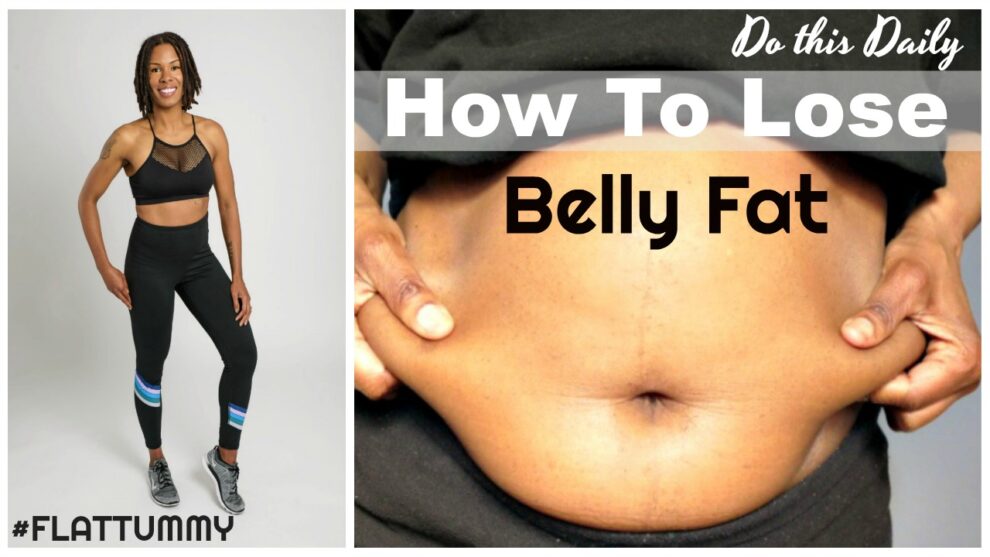The best way to lose weight in the stomach area is through a combination of diet and exercise. A calorie-controlled diet and regular cardiovascular activity are essential.
Losing weight, and specifically targeting the stomach area, is a common goal for many. Attaining a flatter stomach requires dedication to a healthy lifestyle that includes mindful eating and consistent physical activity. It’s important to understand that spot reduction, or losing weight from just one part of the body, isn’t effective; instead, overall body fat must be reduced, which in turn will lead to a slimmer midsection.
Incorporating strength training can also help by building lean muscle, which boosts metabolism and aids in more efficient fat burning. Remember, patience and persistence are key, as results take time and effort.
The Science Of Belly Fat
Understanding the science of belly fat is critical for anyone aiming to lose weight effectively, especially around the stomach area. Belly fat isn’t just a matter of appearance; it also poses significant health risks. To effectively target belly fat, it’s important to delve into the types of fat and the underlying factors that lead to its accumulation. Let’s explore the fascinating science behind belly fat and uncover the best strategies for achieving a flatter, healthier midsection.
Types Of Belly Fat
Belly fat is not a one-size-fits-all; in fact, it comes in two distinct types: subcutaneous and visceral. Subcutaneous fat lies just beneath the skin and is the type you can pinch. On the other hand, visceral fat is hidden deeper within the abdominal cavity, surrounding your organs. It’s this type of fat that’s often linked with various health issues like cardiovascular diseases, diabetes, and metabolic syndrome. Each fat type requires different approaches because of how they metabolically function and impact your health.
Factors Contributing To Belly Fat Accumulation
Several factors play a crucial role in the accumulation of belly fat. From lifestyle choices to genetic predispositions, understanding these can help tailor an effective weight loss strategy. Key factors include:
- Diet: High-calorie and high-sugar diets can lead to an increase in overall body fat, particularly in the abdominal area.
- Inactivity: A sedentary lifestyle is one of the top contributors to gaining belly fat, as it leads to a decrease in calories burned and a slowdown in metabolism.
- Stress: Elevated levels of cortisol, a hormone released in response to stress, are associated with an increase in belly fat.
- Genetics: Your genes can influence how and where your body stores fat.
- Poor Sleep: Research suggests that too little sleep can lead to weight gain, including an increase in belly fat.
- Hormones: Hormonal changes, particularly in women during menopause, can lead to an increase in belly fat distribution.
By addressing these factors, you can create a targeted approach to losing belly fat. Remember, the journey to a slimmer waistline is not only about aesthetics but also about improving overall health and well-being.
The Role Of Nutrition
Embarking on a weight loss journey targeting the stomach area transcends the repetition of crunches and planks. What many fail to realize is that the foundation for a flatter belly begins with forks and spoons. Nutrition plays a crucial role in shaping our bodies, a symphony where macronutrients and food choices conduct the rhythm of fat loss.
Impact Of Macronutrients On Belly Fat
Each macronutrient – carbohydrates, proteins, and fats – influences belly fat differently. Proteins, for example, can enhance metabolism and reduce cravings, aiding in weight control. Carbohydrates, particularly refined ones, often contribute to increased fat storage around the midsection when consumed in excess. Meanwhile, healthy fats, contrary to popular belief, can support weight loss when they replace saturated fats and are consumed in moderation.
- Proteins: Boost metabolism, build lean muscle, and reduce appetite
- Carbohydrates: Essential for energy; but should be chosen wisely (whole grains over refined)
- Fats: Necessary for hormonal balance; focus on unsaturated sources like avocados and nuts
Recommended Dietary Changes For Belly Fat Reduction
To start chipping away at that stubborn belly fat, consider these dietary adjustments:
- Increasing Fiber: High-fiber foods such as fruits, vegetables, and whole grains can help in feeling fuller longer and suppressing appetite.
- Controlling Portion Sizes: Eating in moderation is key to preventing overconsumption of calories which directly impacts weight gain.
- Balancing Macros: Aim for a balanced distribution of macronutrients, attuned to your body’s needs and weight loss goals.
- Limiting Added Sugars: Minimize the intake of sugary drinks and snacks which contribute significantly to abdominal fat accumulation.
- Staying Hydrated: Water intake is essential, not only for overall health but it can also help in managing food intake and reducing bloating.
Small, consistent changes in diet have the potential to result in significant reductions in belly fat. Tailor your nutrition, adjust as needed, and observe as the journey towards a trimmer waist unfolds.
Targeted Abdominal Workouts
If shedding belly fat is on the agenda, understanding the role of targeted abdominal workouts is crucial. These exercises don’t directly burn stomach fat, but rather help strengthen and tone the underlying muscles, contributing to a firmer midsection. Embracing a holistic approach that combines targeted ab exercises with cardio can be the winning strategy for losing weight on the stomach. Let’s take a closer look at how specific exercises and broader workout routines can help sculpt those abdominal muscles effectively.
Best Exercises For Toning The Abdominal Muscles
The quest for toned abs often leads to a myriad of exercises, but not all are created equal. Prioritizing movements that engage the entire core can yield impressive results. Here are some top exercises to include in your routine:
- Planks: A static exercise that requires you to hold your body in a straight line, engaging your entire core, for a set period.
- Bicycle Crunches: These hit all areas of your abs, with a particular focus on the obliques.
- Russian Twists: Sitting on the floor and twisting your torso, you can use a medicine ball or weight for added resistance.
- Mountain Climbers: These not only target the abs but also increase your heart rate, offering mild cardio benefits.
- Reverse Crunches: By lifting your hips off the ground, you target the lower abs effectively.
Incorporating Cardio For Overall Fat Loss
To see the definition in your abdominal muscles, reducing overall body fat is essential. Cardiovascular exercises are fundamental in creating a calorie deficit that helps shed fat from all over the body, including the stomach area. Here are some effective methods to blend into your fitness regimen:
- High-Intensity Interval Training (HIIT): This method involves short bursts of intense activity followed by brief rest periods, kickstarting your metabolism.
- Running: An excellent way to burn calories quickly, it can be adjusted in intensity to suit your fitness level.
- Cycling: Whether stationary or on the road, cycling is a great way to engage your lower body while improving cardiovascular health.
- Swimming: An all-body workout that’s low-impact yet highly effective for burning calories and toning muscles.
- Jump Roping: An underrated cardio workout that blazes calories and can be done almost anywhere.
Remember, a mix of targeted abdominal workouts and consistent cardio sessions paves the way to a flatter stomach. Coupled with a balanced diet and adequate hydration, your efforts will pay off, revealing a more toned and defined midsection.
Healthy Daily Practices
Embarking on a weight loss journey, especially targeting the stomach, requires more than just diet and exercise. Incorporating healthy daily practices into your routine can have a significant impact. Not only do these habits contribute to overall well-being, but they also play a specific role in shaping your weight loss success. Let’s delve into how essential components such as adequate sleep and stress management can help in reducing belly fat and create a sustainable, healthy lifestyle.
Importance Of Adequate Sleep For Weight Loss
Getting enough sleep is paramount when you’re trying to lose weight, particularly around the stomach area. During sleep, your body works to regulate hunger hormones, ghrelin and leptin. A lack of sleep can disrupt this balance, leading to increased appetite and cravings. Moreover, sleep plays a role in metabolism and the way your body stores carbohydrates and fats. To optimize your weight loss efforts:
- Ensure 7-9 hours of quality sleep per night.
- Establish a consistent sleep schedule to regulate your body clock.
- Make your bedroom a sanctuary for sleep: dark, quiet, and cool.
- Avoid heavy meals, caffeine, and electronics before bedtime.
Stress Management And Its Impact On Belly Fat
Stress directly influences weight gain, particularly around your midsection. When stressed, your body produces cortisol, a hormone that can lead to increased abdominal fat. To combat this, effective stress management techniques are essential. Practice:
- Mindfulness and meditation to calm the mind.
- Regular physical activity to reduce stress hormones.
- Deep-breathing exercises to maintain a relaxed state.
- Engage in hobbies or interests that bring joy and reduce stress.
By incorporating these practices into your daily routine, you create a solid foundation to support your weight loss goals and foster a healthier, happier you.
Dietary Supplements For Belly Fat Reduction
Struggling to trim that stubborn belly fat? You’re not alone. Many people find the midsection a challenging area to tone and reduce. While a healthy diet and regular exercise are paramount, dietary supplements can also play a supportive role in your belly fat reduction journey. Before considering supplementation, it’s essential to understand which natural remedies might aid in this endeavor and how your metabolism influences the process.
Exploring natural remedies and supplementsExploring Natural Remedies And Supplements
When it comes to targeting belly fat, the market is inundated with a range of natural remedies and supplements. However, not all are created equal. It is crucial to opt for supplements backed by scientific research, offering a safe and natural boost to your weight loss efforts. Here are some popular options:
- Green Tea Extract: Known for its antioxidant properties, green tea extract can increase metabolism and the body’s ability to burn fat.
- Conjugated Linoleic Acid (CLA): CLA has been linked to reduced body fat in some studies, though others show minimal effects.
- Fiber Supplements: Such as glucomannan or psyllium husk, can help keep you fuller longer, reducing overall calorie intake.
- Probiotics: These beneficial bacteria may improve digestive health and potentially contribute to a slight reduction in weight and belly fat.
Integrating these supplements into your diet can offer a helping hand, but ensure they coincide with overall lifestyle changes for optimal results.
Understanding the role of metabolism in belly fat lossUnderstanding The Role Of Metabolism In Belly Fat Loss
Metabolism plays a pivotal role in how quickly your body burns calories. An active metabolism helps in the reduction of belly fat by converting food into energy more efficiently. Several factors influence your metabolic rate:
| Factor | Impact on Metabolism |
|---|---|
| Age | Metabolic rate generally slows as you age. |
| Muscle Mass | More muscle increases the rate at which you burn calories. |
| Physical Activity | Regular exercise boosts metabolism. |
| Hormonal Factors | Hormonal imbalances can slow metabolism, making it harder to lose belly fat. |
To enhance your metabolism, focus on building lean muscle through resistance training and consume small, frequent meals throughout the day to keep it active. Certain supplements can also help support metabolic function, though they should never replace the foundational elements of a healthy lifestyle.

Credit: beautybydrcat.com
Frequently Asked Questions For Best Way Lose Weight On Stomach
What Are Effective Stomach Weight Loss Strategies?
Effective strategies for stomach weight loss include a balanced diet, regular cardiovascular and core-strengthening exercises. Reducing stress and getting enough sleep are also crucial for targeting belly fat. Consistency is key for long-term success.
Can Diet Alone Flatten My Stomach?
Diet alone can help reduce overall body fat, including on the stomach. Focus on foods high in fiber and protein while cutting back on sugars and refined carbs. However, combining diet with exercise tends to yield quicker, more sustainable results.
How Does Stress Affect Belly Fat?
Stress triggers the production of the hormone cortisol, which can increase appetite and drive abdominal fat storage. Managing stress through relaxation techniques, sufficient sleep, and physical activity can prevent excess cortisol and mitigate its effects on belly fat.
Are There Quick Ways To Lose Belly Fat?
While there’s no immediate fix, long-term strategies like a high-protein diet, regular exercise, and hydration can lead to gradual, sustainable belly fat loss. Avoid quick-fix diets as they often result in temporary weight loss with potential health risks.
Conclusion
Shedding belly fat takes commitment and the right approach. Adopting a healthier diet, regular exercise, and sufficient sleep sets the groundwork. Remember, consistency is key to seeing results. Start your journey today and embrace the transformation that awaits you. Embrace confidence as you achieve your weight loss goals.
















Add Comment